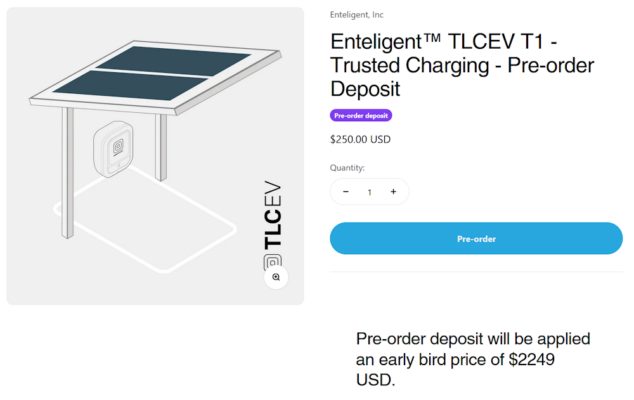It’s a cool idea, but I’ll pass, especially at that price…

Every so often I run across someone advocating for residential DC EV slow charging. It seems like a great concept if you have solar panels. Doing this would bypass the DC-AC-DC conversion between the PV and your car; unlocking sweet, sweet efficiency right? The problem is that while that is conceptually accurate, in practice it’s a more complicated, especially if you add a battery so you don’t lose all the electricity that is captured by the panels, but has no where to go if there isn’t a car currently charging.
To better understand this, we need to break down how the Enteligent TLCEV T1 works. But before doing that, let me quickly say that even though more broadly, I think this is a really hard sell, in niche applications, it might make sense. But, as we will discuss more in a sec, given the cost, it might make sense to do the same thing another way.
The TLCEV T1 is a 12.5 kW DC charger. To get that DC, you connect 1-2 strings of solar panels (PV) directly to the EVSE. Perfect right? Well, kind of… Solar panels don’t operate at car charging voltages, which are usually nominally 400V or 800V. According to the spec sheet, it accepts 340-600V PV input and outputs 250-550V via a CCS or NACS (communication is CCS regardless of physical connector type). To get to the input voltage that you need to serially connect multiple panels into strings; 5-6 should work for most panels to get into the input voltage range. That voltage is unlikely to be constant, because sunlight isn’t constant.
They don’t say if there is a step down/up converter, to smooth out and mange the difference between input/output voltage, but it’s hard to see how this would work otherwise. That’s not free, this site indicates that DC-DC transformer efficiency is ~95%.
So you know how I mentioned that sunlight isn’t constant. Batteries are a great way to insulate you from some of that. What if we hooked up a battery (ESS) to the PV+EVSE to capture that electricity that would otherwise be lost. Definitely helps solve some of the “what if the sun isn’t shining” problems. We still need the step up/down transformer, because most batteries are 48V nominal. So no getting around that loss, and the ESS has to be located very close to the EVSE, like 6-8′. To locate them further away, we would need to step up the voltage for smaller wires.
If this thing is sitting out in the woods, or I guess, better yet a clearing in the woods with nothing around. That’s a decent way to solve the EV charging problem. But, why would you put an EVSE out in the woods with nothing else around?
Oh, maybe you have a cabin in the woods, so there’s no grid or you don’t want to deal with the hassle of getting the permits to connect your PV+ESS to the grid (although, remember the grid is an awesome battery). So it’s a clear winner there too, right?
Well, not exactly.
It will cost a little more to match the capability of the TLCEV T1 with what I would do in this situation, but if you don’t need to match the capability, you can do it for less, and get WAY MORE functionality in your “off-grid” cabin (or whatever) and only lose a small amount of efficiency by introducing AC to the party. Hear me out.
One EG4 6000XP is $1,400. That lets you DC couple 8kW of PV and do 6kW of continuous 240V output. Add a second one, and you get 16kw input, 12kW of output. Add ESS, because that makes sense, and you can power all of the AC gadgets in your cabin while you charge the car, even if the sun isn’t shining. It is slightly less efficient, EG4 says 93% efficiency. But does that really matter given the extra functionality and isolation from the sun needs to be shining problem? I don’t think so.
What about the permits, you definitely need that to install a hybrid inverter and some batteries, right? Not necessarily. Definitely check with your locale, but in most places because the 6000XP is either installed off-grid, like the TLCEV T1, or behind the grid with no backfeed, you don’t generally need any permits that you wouldn’t otherwise need for electrical work (i.e. the landscape should be equivalent b/w the TLCEV T1 and 6000XP here).
So yeah, cool idea, but meh…
Charge for free while the sun shines directly from solar panels. Avoid costly AC to DC conversion losses, lengthy permitting processes and complicated grid integration.
How the pre-order price is calculated.
Preordering with a fully refundable deposit provides you with a discount of 10% off the MSRP of $2499.00 USD. Your final cost will be $2249.00 USD plus applicable shipping and taxes. Fifteen days before your item is shipped, we will ask for the balance of payment: $1999.00 USD plus applicable shipping and taxes.
